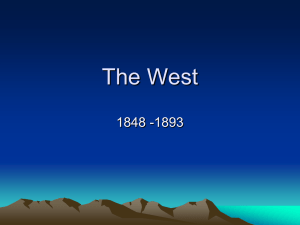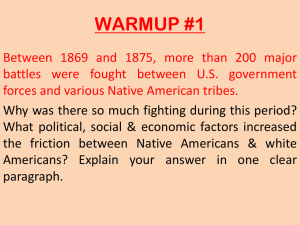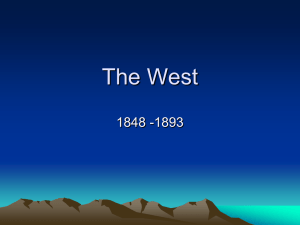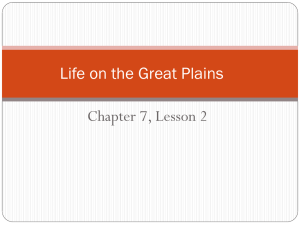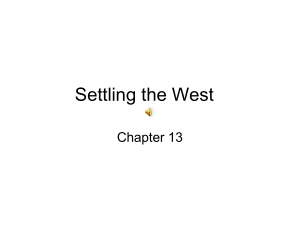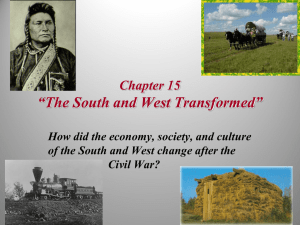CH05Pres
advertisement
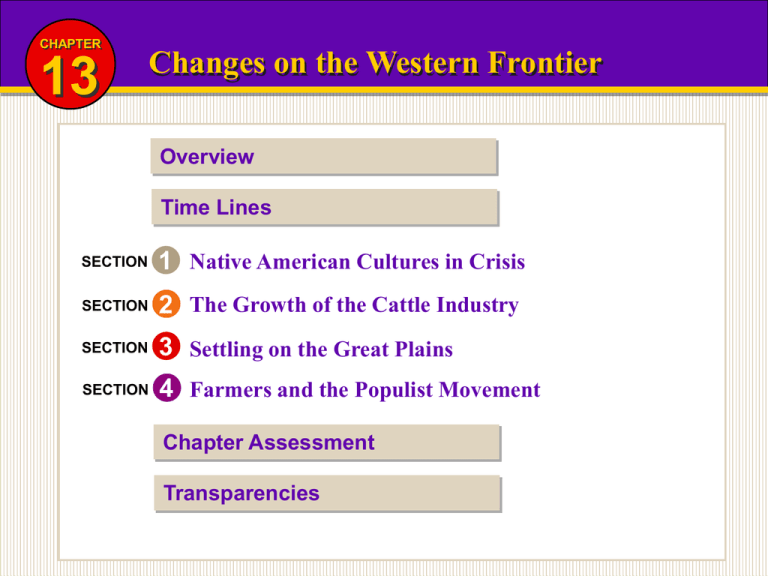
CHAPTER 13 Changes on the Western Frontier Overview Time Lines SECTION 1 Native American Cultures in Crisis SECTION 2 The Growth of the Cattle Industry SECTION 3 Settling on the Great Plains SECTION 4 Farmers and the Populist Movement Chapter Assessment Transparencies CHAPTER 13 Changes on the Western Frontier “My people have always been the friends of white men. Why are you in such a hurry?” Chief Joseph of the Nez Perce to U.S. Army general O.O. Howard, 1877 THEMES IN CHAPTER 13 The American Dream Cultural Diversity Economic Opportunity Women in America HOME CHAPTER 13 Changes on the Western Frontier Frontier: a region just beyond the edge of a settled area The American Heritage Dictionary What do you know? • What does the word frontier mean to you? Read the definition above and answer the following: • What images come to mind when you think of the Western frontier? • Where did the frontier begin? Where did it end? • Are there any frontiers left in this country today? If so, what are they? If not, why not? HOME CHAPTER 13 Time Line The United States 1870 Red Cloud, chief of the Oglala Sioux, states his people’s case in Washington, D.C. 1876 George A. Custer and his troops are killed at Little Bighorn. 1879 Thomas A. Edison invents the light bulb. 1887 The worst blizzard in American history causes a great “die-up” of cattle on the plains. 1890 Native Americans follow the Paiute prophet Wovoka in performing the Ghost Dance, in hope of reclaiming their lands. 1893 Collapse of railroads triggers Panic of 1893. 1896 William Jennings Bryan runs for president in support of free silver. HOME CHAPTER 13 Time Line The World 1870 Impressionism becomes an influential art form in France. 1872 Secret ballot is adopted in Great Britain. 1881 French occupy Tunisia. 1885 Karl Benz builds the first automobile powered by internal-combustion engine. Berlin Conference divides Africa among European nations. 1894 Sino-Japanese War is fought. 1899 Boer War in South Africa begins. HOME SECTION 1 Native American Cultures in Crisis Learn About the Native Americans’ and settlers’ ways of life. To Understand the conflicts that occurred during settlement of the Western frontier. HOME SECTION 1 Native American Cultures in Crisis Key Idea Pursuit of economic opportunity leads settlers to push westward, forcing confrontation with established Native American cultures. HOME SECTION 1 Native American Cultures in Crisis HOME Section 1 Assessment SUMMARIZING What are important details about the culture of the Plains Indians? Culture of the Plains Indians BUFFALO AND HORSE: buffalo–source of food, clothes, shelter horse–source of transportation BELIEFS: world inhabited by spirits focus on the present, not the future FAMILY LIFE: communal property and government individualism valued SECTION 1 Native American Cultures in Crisis Section 1 Assessment RECOGNIZING EFFECTS This chapter says that the destruction of the buffalo was “perhaps the most significant blow to tribal life.” Explain why you agree or disagree with this statement. THINK ABOUT • how Native Americans used the buffalo • how Native Americans viewed ownership of land HOME SECTION 1 Native American Cultures in Crisis Section 1 Assessment EVALUATING Why do you think the assimilation policy of the Dawes Act failed? THINK ABOUT • the experience of Native Americans such as Zitkala-Sa • the attitudes of many white leaders toward Native Americans • the merits of owning property • the importance of people’s cultural heritage HOME SECTION 2 The Growth of the Cattle Industry HOME Learn About the cowboy’s life and work. To Understand the difference between the myth and the reality of the cowboy. SECTION 2 The Growth of the Cattle Industry Key Idea The cattle industry thrives as the culture of the Great Plains Indians declines, and a new worker–the cowboy–appears on the scene. HOME SECTION 2 The Growth of the Cattle Industry HOME Section 2 Assessment SUMMARIZING What were some of the reasons for the rise and decline of the cattle frontier? CATTLE FRONTIER RISE DECLINE Mexican culture Overgrazing Railroads Natural disasters Growth of Eastern cities Invention of barbed wire SECTION 2 The Growth of the Cattle Industry Section 2 Assessment COMPARING AND CONTRASTING How were cowboys in the United States similar to and different from Mexican vaqueros? THINK ABOUT • their reasons for working • the skills required • the equipment they used • their ethnic backgrounds HOME SECTION 2 The Growth of the Cattle Industry Section 2 Assessment SYNTHESIZING Create a monologue in which someone in this section, such as a typical cowboy, discusses life on the cattle frontier. THINK ABOUT • how the person knows about the cattle frontier • the person’s attitude toward the frontier • how the person expresses his or her attitude HOME SECTION 3 Settling on the Great Plains Learn About the life of farmers on the Great Plains. To Understand how the settlers endured hardships and transformed the land. HOME SECTION 3 Settling on the Great Plains Key Idea The promise of cheap, fertile land draws thousands of settlers westward to seek their fortunes as farmers. HOME SECTION 3 Settling on the Great Plains HOME Section 3 Assessment 3 SEQUENCING HISTORY What were at least four events that shaped the settling of the Great Plains? 1862 Homestead Act 1874 Development of barbed wire 1869 Completion of the first transcontinental railroad 1893 Turner’s essay on the frontier 1889 Oklahoma land rush SECTION 3 Settling on the Great Plains GENERALIZING Section 3 Assessment 3 Review the changes in technology that influenced the life of settlers in the Great Plains in the late 1800s. Explain how you think settlement of the plains would have been different without these inventions. THINK ABOUT • the tasks done by the settlers • tools and methods previously used • the inventions that became widely used in the late 1800s HOME SECTION 3 Settling on the Great Plains Section 3 Assessment EVALUATING How successful were governmental efforts to promote settlement of the Great Plains? THINK ABOUT • the growth in population on the Great Plains • the role of railroads in the economy • the results of the Homestead Act HOME SECTION 4 Farmers and the Populist Movement HOME Learn About pressures that made farming increasingly unprofitable. To Understand the rise and fall of the Populist movement. SECTION 4 Farmers and the Populist Movement Key Idea Farmers band together to address their economic problems, giving rise to the Populist movement. HOME SECTION 4 Farmers and the Populist Movement HOME Section 4 Assessment ANALYZING CAUSES AND EFFECTS What were some of the causes for the rise of the Populist Party and the effects the party had? CAUSES EFFECTS Falling prices for crops Inability to repay loans High railroad rates New ideas that later become law Political forum for addressing special interests Message of hope to downtrodden Populist Party SECTION 4 Farmers and the Populist Movement Section 4 Assessment APPLYING Rank the following four factors in order of the impact you think they had on bringing an end to the Populist Party. • support for free silver • lack of wealthy backers • advocating a greater voice in government • third-party status HOME SECTION 4 Farmers and the Populist Movement Section 4 Assessment FORMING AN OPINION Who do you think was most to blame for the Panic of 1893: (1) farmers and businesspeople, (2) railroads and banks, or (3) government? THINK ABOUT • the actions of each group prior to the Panic of 1893 • the causes of the panic • the business cycle HOME Chapter 13 Assessment 1. Identify three significant differences between the culture of the Native Americans and that of the white settlers on the Great Plains. 2. How did the conflict over the Bozeman Trail symbolize the difficulties Native Americans faced? 3. How effective was the Dawes Act in promoting assimilation of Native Americans into white culture? 4. Why did the cattle industry become a big business in the late 1800s? 5. How did cowboy culture reflect the ethnic diversity of the United States? HOME Chapter 13 Assessment 6. How did the real life cowboys differ from the myths about them? 7. What measures did the government take to support settlement of the frontier? 8. How did settlers overcome the challenges of living on the Great Plains? 9. What economic problems confronted American farmers in the 1890s? 10. According to farmers and other supporters of free silver, how would bimetallism help the economy? HOME

